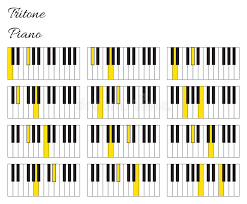Formation of tritones (in depth) Second Lesson
We are continuing from where we stopped last time, analyzing how a tritone and ditone voicings are based on quartal harmony.
Let's look at a ditone voicing by first asking what a ditone is. A ditone is the division of an octave into 4 equal parts, and can be measured by the interval of a major 3rd, e.g. CE and AbC.
There are about 3 or 4 differently voiced ditone patterns. We will consider 2 here today. The first has a pattern of 6+2+5/R+3 and gives a maj6add9 chord, while the second has a pattern of b7+#9+#5/R+3 and gives a 7#5#9.
A good look at both voicings show the LH as R+3 which is a diminished 4th interval.
The first pattern has the RH as 6+2+5 which is a quartal voicing for a suspended triad, all notes having a perfect 4th interval between them. The LH top note [3] and the RH bottom note [6] have a perfect 4th interval between them too, making this voicing an all 4th interval voicing.
An example is BbEbAb/DbF which is Dbmaj6add9 a.k.a. Db6/9 chord. This chord easily replaces the Dbmaj triad.
The second voicing has the RH as b7+#9+#5 which is also a quartal voicing having perfect 4th intervals between the notes . The LH top note [3] and the RH bottom note [b7] have an augmented 4th [tritone] interval between them.
An example is EAD/GbBb which is Gb7#5#9, an altered dominant chord.
It is worth nothing that this 2nd ditone voicing is just an inversion of the tritone voicing.
Gb.Bb.E.A.D can be inverted once to get Bb.E.A.D.Gb and voiced as ADGb/BbE which is a tritone voicing as Dmaj/Bb tritone pair.
Those passing or approach [altered dominant] chords can be voiced as a tritone or ditone.
Try ADG/BD# ~ ADG/CE i.e B7#5#9 to C6/9.

#pianolessons #chords #scales #piano #chordprogression #inversions #tutorial #music #tritones #jazz #lesson #movement